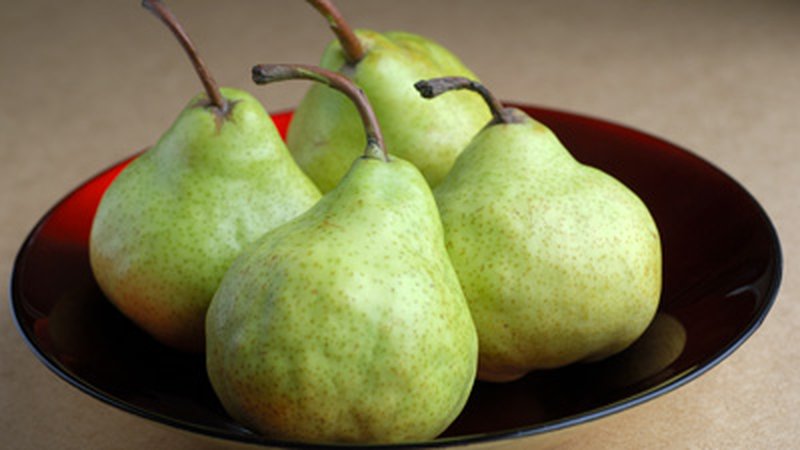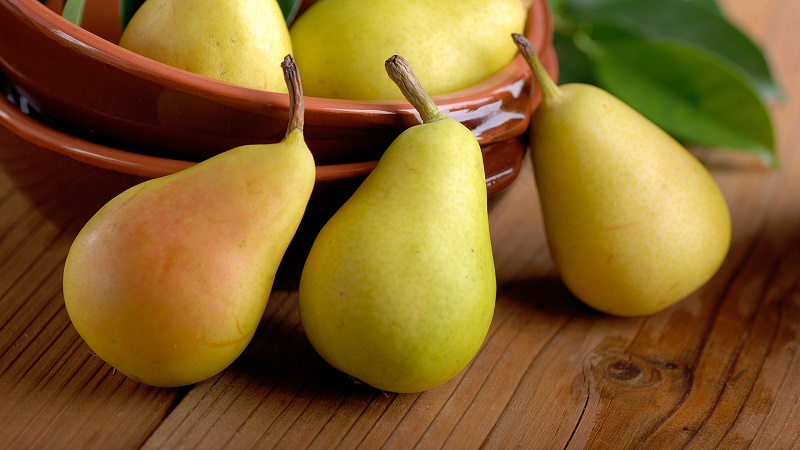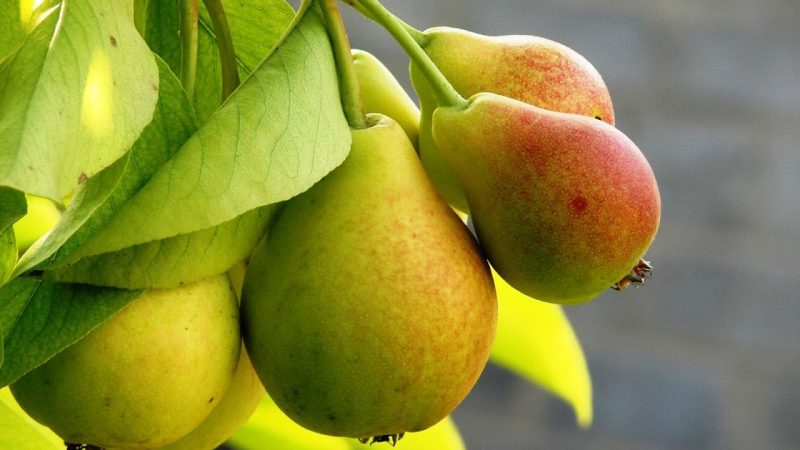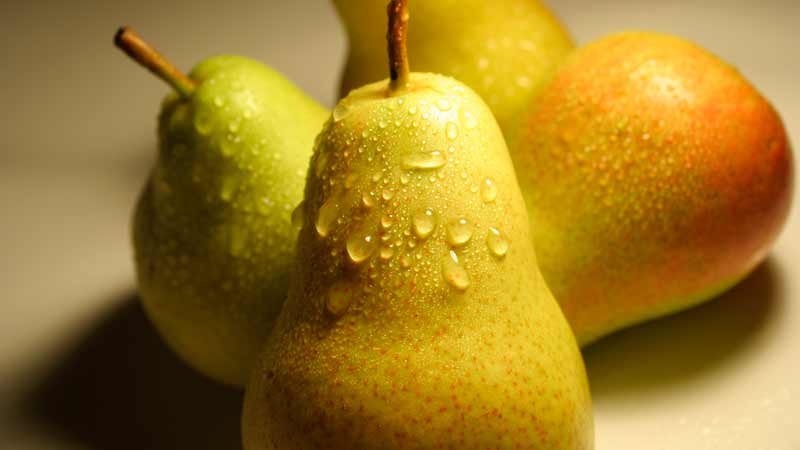The chemical composition of the pear, calorie content and its benefits and harm to health
Pear is the queen of fruits. It has a low calorie content, has almost no contraindications for use, contains many elements and vitamins necessary for the body. Why are these fruits so useful, and are there pitfalls when using them? You will learn about this and much more in our article.
The content of the article
Calorie pear

Caloric content and ratio of BZHU differ depending on the variety. Consider the composition and calorie content of the most popular.
| Variety | Kcal content per 100 g | Glycemic index | Proteins, fats, carbohydrates (BJU), g |
| Bartlett | 63 | 30 | 0,4*0,2*11,9 |
| Chinese | 42 | 24 | 0,5*0,2*10,7 |
| The conference | 42,9 | 24 | 0,4*0,3*10,3 |
Vitamin content:
- copper - 7.8 mcg;
- silicon - 6 mg;
- manganese - 0.037 mg;
- iron - 0.19 mg;
- phosphorus - 11 mg;
- magnesium - 6 mg;
- calcium - 9 mg;
- zinc - 0.08 mg;
- potassium - 101 mg;
- vitamin C - 4.4 mg;
- vitamin K - 3.8 mcg;
- vitamin PP - 0.164 mg;
- vitamin E - 0.12 mg;
- vitamin B6 - 0.026 mg;
- vitamin B5 - 0.042 mg;
- vitamin B4 - 5.1 mg;
- vitamin B1 - 0.012 mg;
- vitamin B2 - 0.026 mg.
How many calories in 100 g

When drawing up a dietary ration it is important to understand the calorie content of 100 g of the product, as well as the average weight of fruits and vegetables.
In a whole fresh pear
Depending on the variety of pear weighs from 100 to 180 g, the average weight of the fruit is about 130 g. There are also larger specimens. The average calorie content of the fruit is 55 kcal.
In juice
Freshly squeezed pear juice contains about 45 kcal per 100 g, clarified - 46-50 kcal.
In processed fruit
When a fruit is processed, its calorie content and nutritional value change. So, for 100 g of dried pears there are 201 kcal, baked fruit contains 179.8 kcal, dried - 249 kcal.
Canned pears contain an average of 65 kcal. For 100 g of pear jam there are 214.6 kcal, jam - 211.7 kcal, jam - 215 kcal. Pear marshmallow can contain 300-320 kcal.
Is it possible to eat pears on a diet

Pear is a fat-burning fruit. Despite its pronounced sweetness, it contains few calories, and the high fiber content inhibits the absorption of carbohydrates and stimulates the small intestine.
The high content of trace elements and vitamins normalizes metabolism, improves the condition of hair and skin, restores the proper functioning of the digestive tract, and has a beneficial effect on the endocrine, circulatory and nervous systems. Folic acid in pears supports immunity, stimulates the production of bile and leukocytes.
Important. For a more complete absorption of nutrients, nutritionists recommend eating pears in the morning after breakfast. Evening consumption irritates the intestines and leads to congestion.
Benefit and harm
As with any product, the pear has positive and negative sides to use.
Of the characteristic advantages are:
- low calorie content;
- high fiber content;
- normalization of metabolism;
- normalization of the gastrointestinal tract;
- increasing the functionality of the liver and kidneys;
- increasing the body's resistance to infections;
- reduction of inflammatory processes in the body;
- restoration of the hematopoietic system;
- strengthening of the vascular walls;
- normalization of blood sugar levels;
- reduction of edema;
- reducing the risk of developing cancer;
- increased hemoglobin levels;
- restoration of the menstrual cycle in women and increased potency in men;
- reducing the risks of developing premenstrual syndrome and combating its manifestations.
Despite the extensive list of pros, there are significant downsides:
- pronounced diuretic effect;
- allergic reactions;
- strong stimulation of digestion;
- dyspeptic symptoms - nausea, vomiting, diarrhea, bloating;
- can cause fermentation in the intestines when used with fatty meats, smoked meats and dairy products;
- contraindicated in certain diseases of the gastrointestinal tract.
How to choose and store correctly

To get the most out of the fruit, it is important to select and store it correctly. In stores, you can most often find unripe pears that need to lie down and ripen. They are kept for several days at room temperature - then they get the maximum benefit.
When choosing, be sure to pay attention to the following characteristics:
- there should be no blackheads, dents, cracks on the skin;
- a good pear has a subtle pleasant smell, too strong an aroma is a sign of fruit spoilage;
- the surface should not have a greasy bloom or shine - a normal pear has a matte, somewhat waxy bloom;
- the stalk is soft, elastic, does not break when trying to bend it, brittle and dry speaks of an old fruit.
Pears are stored in the refrigerator in pre-drilled paper or plastic bags. It is undesirable to store more than 0.5 kg of fruits in one package. In this state, the fruit can be stored for up to a month. At room temperature, it can be stored for a short time in boxes with holes for better ventilation - up to two weeks.
For long-term storage, the fruit is placed on glazed balconies, after wrapping each one with paper or parchment. In this state, the fruits can be stored for up to three months.
Reference. Pears tolerate freezing well in any form, the main thing is to defrost correctly.
Consumption rates per day

The norm for an adult is 1-2 fruits per day. More is allowed, however, when such a number of pears are consumed, the volume of absorbed nutrients decreases in proportion to the amount. Children can be given fruit slices from one and a half years old, from 8-10 months it is allowed to give fruit in the form of puree.
Reference. For children under one year old, a pear is injected with great care in order to avoid allergic phenomena. Starting from 1 tsp. mashed potatoes a day, gradually increase consumption.
Contraindications

Like any product, a pear has its own contraindications for use:
- allergic reactions;
- exacerbation of diseases of the gastrointestinal tract;
- old age - with caution;
- peptic ulcer of the stomach and duodenum.
With diseases of the gastrointestinal tract, pears are allowed for use only with persistent remission lasting more than one year.
Conclusion
Pears can and should be used by people of any age. They provide a wide range of positive effects for the body - they improve the functioning of the gastrointestinal tract, nervous and immune systems, and help fight the manifestations of depression and premenstrual syndrome. Eating in moderation will "sweeten" the diet of dieters.